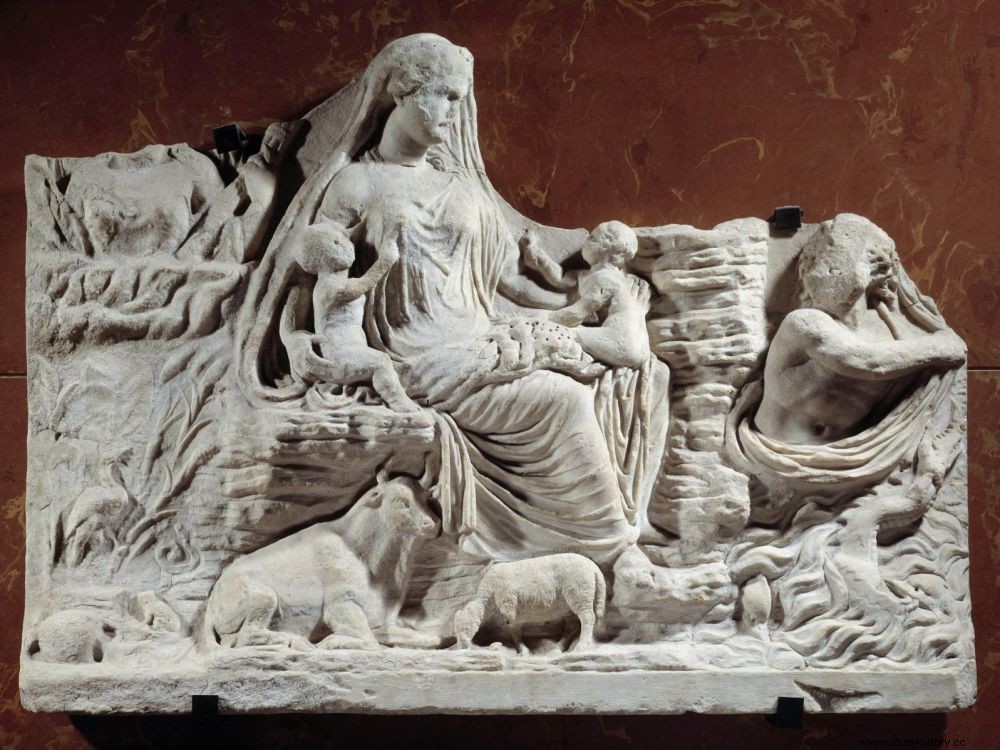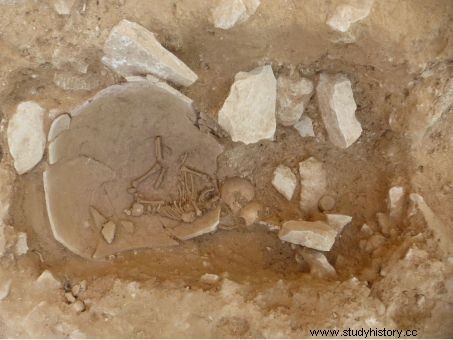About sixty graves of newborns, buried 2,000 years ago, have recently been unearthed at the foot of the ancient Roman ramparts of the city of Nîmes.

Allegorical relief dating from the 2 th century of our era, where the stillbirth rate was very high. Experts estimate that one in three children died during the first year, and only one in two reached adulthood.
The discovery is rare. At the foot of the Roman ramparts of Nîmes, the former capital of the Volques, archaeologists from Inrap (National Institute for Preventive Archaeological Research) recently unearthed the remains of some sixty children's graves, including one fifty newborn babies. Thin and poignant human remains dating back to the first and second centuries AD. Found "outside the walls", outside the walls of the city, they were massed over a hundred m2 at the base of a tower, or in one of the three bastions cleared along the 130m of Roman fortification revealed by the specialists since the origin of the work started in 2013. Drawn up on 6 km, constituting one of the largest ramparts of the time - in comparison to those of Orange or Fréjus -, this armor of stones is the work of Emperor Augustus (63 BC-14 AD) who had it erected between the years 5 and 30 AD.
"The first children's graves appeared in 2017. But we never expected to exhume so many this year!" , says Richard Pellé, the archaeologist in charge of the excavations joined by Sciences et Avenir. The burials are very varied:some are in amphora, others in "olpé" , a Greek term for vases intended for pouring liquids. Still others are in the ground, the bodies having probably been covered with shrouds that no longer exist today, or wrapped in simple basketry, just marked with a stone to materialize the burial.

One of the perinatal burials (buried in formwork, in amphora or in the ground) found at the foot of one of the towers of the Roman walls of Nîmes (Gard). © Inrap
Researchers also found two urns that may be evidence of cremation.
The discovery is rare. At the foot of the Roman ramparts of Nîmes, the former capital of the Volques, archaeologists recently unearthed the remains of around sixty children's graves, including around fifty newborn babies. Thin and poignant human remains dating back to the first and second centuries AD. Found "outside the walls", outside the walls of the city, they were massed over a hundred m 2 at the base of a tower, or in one of the three bastions cleared along the 130m of Roman fortification revealed by the specialists since the origin of the works started in 2013. Erected over 6 km, constituting one of the largest ramparts of At the time - in comparison to those of Orange or Fréjus - this stone cuirass is the work of the Emperor Augustus (63 BC-14 AD) who had it erected between the years 5 and 30 AD.
"The first children's graves appeared in 2017. But we never expected to exhume so many this year!" , says Richard Pellé, the archaeologist of Inrap (National Institute for Preventive Archaeological Research) in charge of the excavations, joined by Sciences et Avenir. The burials are very varied:some are in amphora, others in "olpé" , a Greek term for vases intended for pouring liquids. Still others are in the ground, the bodies having probably been covered with shrouds that no longer exist today, or wrapped in simple basketry, just marked with a stone to materialize the burial.

One of the perinatal burials (buried in formwork, in amphora or in the ground) found at the foot of one of the towers of the Roman walls of Nîmes (Gard). © Inrap
Researchers also found two urns that may be evidence of cremation. These graves were sometimes dug on the site of old adult graves, disturbed over the centuries by the arrival of these perinatal burials. "People probably came there because they had no other place to bury their young" , explains Richard Pellé. This was not the case for the wealthy families who owned vaults where all the relatives were concentrated, mausoleums that can still be seen, following the Domitian way, this Roman road which crossed Narbonne Gaul.

Remains of one of the towers of the enclosure at the foot of which all the burials were found. ©Inrap
Four dog graves, buried with as much care as those given to children, were also among the finds. A stele planted vertically even indicated one of them, whose remains were accompanied by an obol to Charon! A coin dating from Emperor Claudius (10 BC-54 AD) intended for the ferryman who transported the souls of the deceased across the river of the underworld, the Styx. The presence of these dogs among all these children is far from being anecdotal. She recalls the study, in 2015, of hundreds of skeletons of infants and fetuses of the 2 th century before our era found on the agora of Athens (Greece):more than 400 infants had been discovered at the bottom of a well, their bones being mixed with those of dogs. "Their sacrifice would have been linked to purification rites. Ancient texts indeed mentioned the particular ability that this animal would have had to absorb malignant influences, not to mention the link it had with Hecate, the goddess of birth and death, especially those of premature infants" , we already wrote in Sciences et Avenir.
This proves the existence of specific funerary treatments for fetuses, newborns and infants around the ancient Mediterranean as confirmed by the remains exhumed in Nîmes, where archaeologists have in fact essentially identified fetuses and infants up to 6 month. The city of Gard is now considering how the site could be preserved to present this important discovery to the public. In 40 years of local excavations, only about thirty children's graves had been found to date.
Maternity and Early Childhood in Antiquity
Sources of various kinds make it possible to grasp the importance of the attention paid to toddlers despite their high mortality. In a letter written on the 2
th
century of our era, to the Emperor Marc Aurèle, Fronton thus evokes with emotion the loss of his five children who succeeded one another without surviving:"I lost five children which is more in the most painful circumstances of all my life; because [...] I lost them when they were only children. Thus, I have always lost my children without one left to comfort me ."
To read in The smile of Omphale. Maternity and early childhood in Antiquity , by Véronique Dassen, Presses Universitaires de Rennes, 2015.
